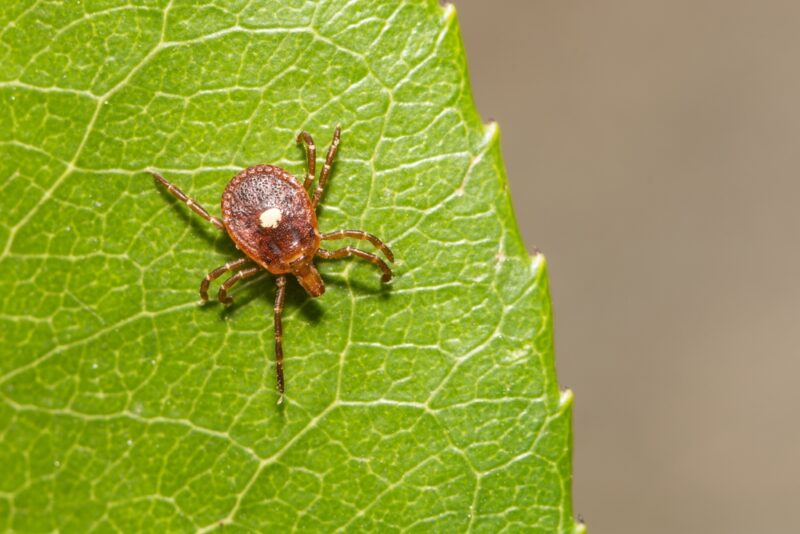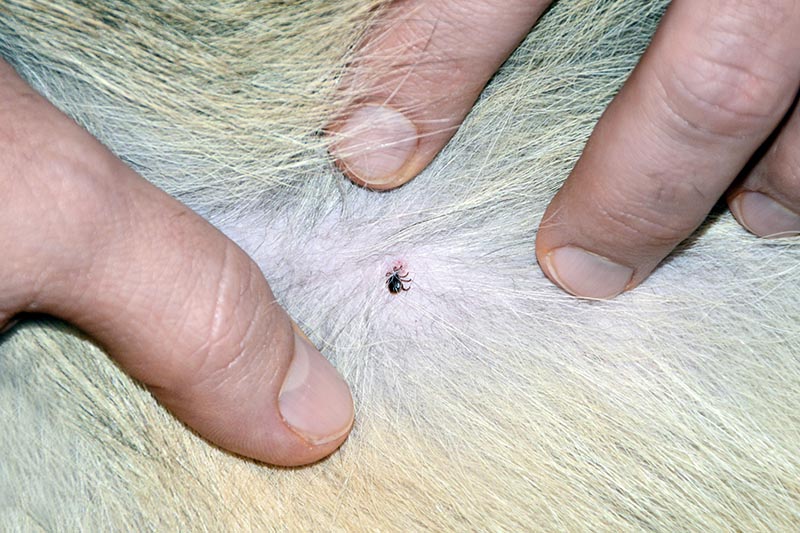6 Types of Ticks in Arkansas (With Pictures)
-
Brooke Billingsley
- Last updated:

If you’ve ever been to Arkansas, then you know how perfect the state is for getting outdoors. Arkansas is home to the mountain biking capital of the world (Bentonville), as well as 52 state parks, hundreds of hiking and backpacking trails, and Hot Springs National Park. A large portion of the state is undeveloped land, with some being used for pleasure and some for conservation.
Arkansas holds the title of the Natural State, and it proves itself to be the Natural State every day.
Unfortunately, with so much nature and so many outdoor activities, ticks are inevitable. They are gross, difficult to deal with, and willing to attach themselves to just about any living thing they can, from you to your dog. How many types of ticks are there in Arkansas? Should you be concerned about all of them?
Is Anywhere Safe from Ticks?
Wherever your favorite outdoor spot in Arkansas is, you almost certainly know that there are ticks here. Ticks are unpleasant, blood-sucking, parasitic, disease-carrying arachnids. They have one of the largest distributions of any disease vector in the world, existing on every continent. You might have been waiting for the “except Antarctica” at the end of that, but they have been found there too.
The 6 Types of Ticks Found In Arkansas
1. American Dog Tick

| Size: | 5–15 mm |
| Range: | All of Arkansas |
| Vector of: | Rocky Mountain Spotted Fever, Tularemia |
The American dog tick is also sometimes called the wood tick. This tick carries the bacteria that cause both Rocky Mountain spotted fever and Tularemia, and it is a very common tick across more than half of the United States. In some cases, they have also been known to be vectors of anaplasmosis and ehrlichia.
They are also capable of causing tick paralysis, which is caused by a neurotoxin in these ticks. It can lead to progressive paralysis in a fashion similar to Guillain-Barre syndrome. They can get quite large, with an engorged female tick reaching up to ½ inch in size.
2. Brown Dog Tick

| Size: | 2.3–3.2 mm |
| Range: | All of Arkansas |
| Vector of: | Rocky Mountain Spotted Fever |
The brown dog tick may start off as a small tick with a distinctly elongated body, but engorged females can exceed ½ inch after feeding, sometimes reaching the size of a raisin. In fact, females can increase their size to 100 times larger than normal when feeding.
You may also see these ticks referred to as kennel ticks or pantropical dog ticks. These ticks are found in every state in the continental United States, and they live in every corner of Arkansas, although they prefer warmer climates and are far more likely to be active in the warmer months.
Unlike most ticks, the brown dog tick can complete its entire life cycle indoors, making them a risk for infestation of homes. They are one of the most prevalent disease vectors for dogs, carrying canine babesiosis and ehrlichia. For humans, their primary risk is the transmission of Rocky Mountain spotted fever.
3. Blacklegged Tick

| Size: | Up to 3.5 mm |
| Range: | Most of Arkansas |
| Vector of: | Anaplasmosis, Babesiosis, Lyme Disease |
The blacklegged tick is present across the entirety of Arkansas, although their presence is far more prevalent in certain counties. These counties are spread across the state, but they are most prevalent in Northwest and Northern Arkansas. They seem to be less common in counties that border the Mississippi River. You may also see these ticks referred to as deer ticks, and in some places, they are called bear ticks.
These ticks start out the size of a sesame seed or smaller, but they can exceed ¼ inch when engorged. They are vectors of multiple diseases that can impact humans, including anaplasmosis and babesiosis. They can also carry Lyme disease, but Lyme disease is quite rare in Arkansas.
4. Lone Star Tick

| Size: | 0.5–1 mm |
| Range: | All of Arkansas |
| Vector of: | Ehrlichiosis, tularemia, STARI |
The lone star tick is also called the Northeastern water tick and turkey tick, and it is the species of tick that you may also call seed ticks. Seed ticks are the larval stage of ticks, and their tiny size gives them their name. Seed ticks can attack you by the dozens and can be any type of tick, but they are most commonly lone star ticks. It is named for the white star present on the backs of females, while males usually have white streaks.
They are the primary vector for ehrlichia in humans, but can also carry tularemia and STARI. Southern tick-associated rash illness or STARI, causes a rash that is similar in appearance to that of Lyme disease, and it can also cause fever, muscle pain, joint pain, headaches, and fatigue.
5. Gulf Coast Tick

| Size: | 1.3–6 mm |
| Range: | All of Arkansas |
| Vector of: | Spotted Fever |
Gulf coast ticks are not overly prevalent ticks, usually only occurring in the Southeastern states along the Gulf of Mexico and some of the Atlantic coastal states, although they can occur as far west as Oklahoma and as far north as Virginia. Interestingly, they are prolific when it comes to reproduction, with a female laying over 8,000 eggs. They are relatively large ticks, reaching around ¼ inch when not engorged. These ticks are three-host ticks, which means they require three separate hosts to complete their full lifecycle. They typically spend their time in prairie grasses, but can also be found in shady wooded areas.
Gulf coast ticks are vectors of Rickettsia parkeri, which causes a form of spotted fever that is similar to Rocky Mountain spotted fever. The symptoms are similar, with headaches, fever, and a rash being present, but the presence of Rickettsia parkeri can also lead to tissue death at the site of the tick bite.
6. Groundhog Tick

| Size: | Up to 3.5 mm |
| Range: | All of Arkansas |
| Vector of: | Powassan Virus |
You don’t have to get overly acquainted with the groundhog tick because it is rare for them to bite people. They are most often considered a pest, and they most commonly attach to groundhogs, giving them their name. This doesn’t mean they are not a threat to people, though.
These ticks are not vectors of Lyme disease, but they can carry Powassan virus. Powassan virus was named after the town of Powassan, Ontario, due to the death of a young boy from the virus there. This virus can lead to encephalitis, which is a deadly brain infection. Powassan virus is rare but quite deadly when encountered.
How Can I Prevent Ticks?
If all of this information didn’t gross you out, then you must have an iron mind. Even if the thought of ticks doesn’t give you the heebie-jeebies, it’s still important to do everything in your power to avoid them. Ticks can cause multiple illnesses in humans and our pets, and some of these diseases are deadly. Some people may even suffer lifelong symptoms of tick-borne illnesses.
There are a few ways you can protect yourself from ticks, though. Wearing long pants, long sleeves, and tucking your pants into your shoes can help keep them off of you. Bug spray containing DEET is the best protection against ticks. It can help repel them, although they may need to come into contact with your clothes or skin to be impacted by the bug spray.
For your furry friends, a veterinarian-prescribed tick medication is ideal. There are a variety of products on the market, including collars, topicals, and chews. You should only buy these products from your vet or a reliable veterinary pharmacy to decrease the risk of purchasing dangerous fakes.
After you and your dog have been out in wooded or grassy areas, you should do a thorough tick check for both of you. Whenever possible, have another person check the areas you can’t see on yourself, like your back and scalp. Make sure to check in skin folds and crevices, like armpits, the backs of your knees, and your groin.
Give your dog a thorough check, making sure to part their fur and check skin folds. Some tick prevention medications for pets require the tick to bite your dog to contact the pesticide, so you may find dead or dying ticks that have bitten your dog.
Conclusion
Ticks are one of the negative aspects of spending time outdoors in Arkansas. It’s important to protect yourself since ticks live everywhere in this state. Don’t be afraid of strong bug sprays, and make sure your pet receives tick prevention from your vet. While some people may not like the idea of pesticides on themselves or their pets, it is far better than the alternative of getting a deadly tick-borne disease.
Featured Image Credit: Jay Ondreicka, Shutterstock
Contents
